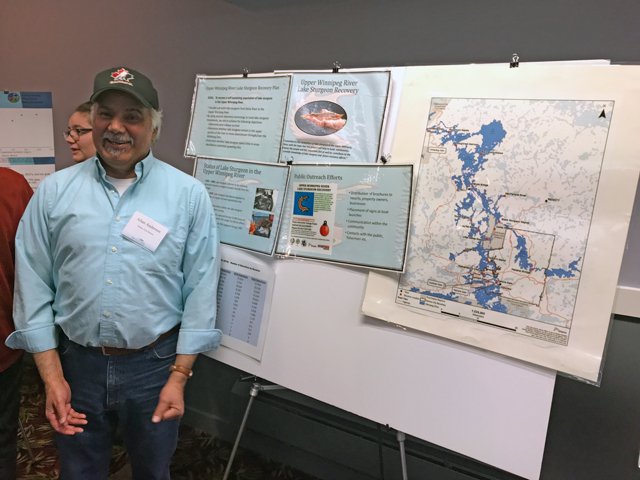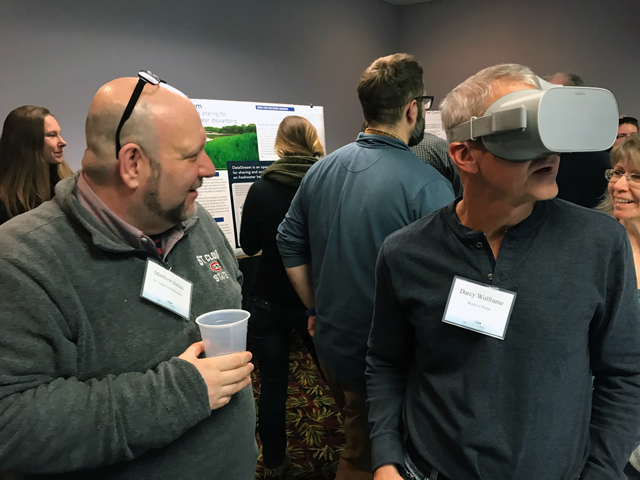 Dr. Michael Paterson, IISD – ELA, presented on impacts of atmospheric mercury on zooplankton and fish. Photo: Dr. Leif Olmanson, U. MinnesotaOn March 13-14, 2019 Lake of the Woods and its watershed went under the microscope at the International Rainy-Lake of the Woods Watershed Forum. Over the years, the annual two-day International Rainy-Lake of the Woods Watershed Forum has grown in attendance and scope – such that it is now better described as “Forum Week”.
Dr. Michael Paterson, IISD – ELA, presented on impacts of atmospheric mercury on zooplankton and fish. Photo: Dr. Leif Olmanson, U. MinnesotaOn March 13-14, 2019 Lake of the Woods and its watershed went under the microscope at the International Rainy-Lake of the Woods Watershed Forum. Over the years, the annual two-day International Rainy-Lake of the Woods Watershed Forum has grown in attendance and scope – such that it is now better described as “Forum Week”.
The agenda this year was jam packed. Despite a major winter storm, over 160 researchers and members of the public attended the symposium sessions, featuring 34 research presentations covering a wide range of topics, including studies of nutrients and algae, satellite remote sensing tools, water quality models, beavers, fish and much more.
The Forum featured dedicated sessions for:
- Updates on the Canadian federal science projects underway on Lake of the Woods and Rainy River that are aimed at informing the development of water quality objectives and targets for phosphorus to reduce harmful algae blooms.
- Science at the IISD-Experimental Lakes Area, including studies of the effects of nanosilver used in clothing, hydroelectric reservoir drawdowns, atmospheric mercury deposition, and the impacts of shoreline spills of conventional heavy oil versus diluted bitumen. This latter study is continuing in the coming year to assess the efficiency of clean up methods for oil spills – a hot topic given the concerns about transportation of oil and dilbit across our watershed.
There were many more presentations – far too many to report on here. A detailed summary of the Forum is available at https://lowwsf.com/forum-proceedings.
It was clear from this Forum that much has been achieved scientifically that positions us to move from pure research to management solutions. Many of the presentations this year focused on knowledge and tools that will inform management actions. Examples were real-time satellite remote sensing tools to assess progress on reducing harmful algae blooms, the use of the sediment history record in lakes to inform management, and on-the-ground projects such as identifying restoration targets for several rivers in Minnesota and the Winnipeg River Sturgeon Recovery Program of the Dalles First Nation in Ontario.
 Alan Anderson, Dalles First Nation, presented details of the Sturgeon Recovery Program on the Winnipeg River in both oral and poster sessions. Photo: Lee GrimThe Dalles First Nation Chief Lorraine Cobiness prefaced the Sturgeon Recovery Program presentation with inspiring comments about the educational and cultural significance of the program and partnerships created, and the importance of working together for common goals and the health and protection of our waters for generations to come. This was a great reminder about the context of what all this research is for.
Alan Anderson, Dalles First Nation, presented details of the Sturgeon Recovery Program on the Winnipeg River in both oral and poster sessions. Photo: Lee GrimThe Dalles First Nation Chief Lorraine Cobiness prefaced the Sturgeon Recovery Program presentation with inspiring comments about the educational and cultural significance of the program and partnerships created, and the importance of working together for common goals and the health and protection of our waters for generations to come. This was a great reminder about the context of what all this research is for.
The Foundation Reception provided a casual venue for networking, recognition awards, and the poster session. This year’s poster session covered a wide range of topics, ranging from the status of spread of zebra mussels in the Big Fork River (they are not in Lake of the Woods!), to monitoring in the Rainy River Basin, to a live demonstration of a virtual reality enhancement of SimRiver, an educational software simulation being used in schools around the world. SimRiver helps students study and understand the relationship between human activity, river environments and a key type of algae, known as diatoms, that are indicators of water quality conditions.
In addition to the symposium presentations, many other sessions took place, including a civic engagement workshop for lake associations and soil and water conservation groups working in the watershed, meetings of the IJC watershed board and its community and industry advisory groups, a public meeting of the watershed board’s water levels committee, and workshops for science experts and the public to engage them in the project of the IJC board to develop international objectives and advisory alert “trigger” levels for water quality and aquatic ecosystem health. All in all, a very busy week indeed.
 At right, Darcy Wolframe of Kenora explores SimRiver using the virtual reality enhancement to the educational software, under the watchful eyes of Professor Matthew Julius of St. Cloud State University (left), one of the collaborators on the SimRiver Diatom project. Photo: Lee GrimSince 2004, the annual International Rainy-Lake of the Woods Watershed Forum has been a strategic incubator for cross-border research, management collaboration, networking and communication.
At right, Darcy Wolframe of Kenora explores SimRiver using the virtual reality enhancement to the educational software, under the watchful eyes of Professor Matthew Julius of St. Cloud State University (left), one of the collaborators on the SimRiver Diatom project. Photo: Lee GrimSince 2004, the annual International Rainy-Lake of the Woods Watershed Forum has been a strategic incubator for cross-border research, management collaboration, networking and communication.
The Foundation leads a partnership of agencies to organize the Forum each year. Attended each year by upwards of 160 research and resource managers, the Forum is the "hub" for all groups working to ensure the future ecological integrity of the waters of the Rainy-Lake of the Woods Basin.
Thanks to our sponsors for assisting with the 2019 International Rainy-Lake of the Woods Watershed Forum. This event would not be possible without the dedicated efforts of the researchers and resource managers and the assistance of the following groups:
- International Joint Commission
- Voyageurs National Park
- Consulate General of Canada - Minneapolis, Global Affairs Canada
- Minnesota Pollution Control Agency
- Rainy River Community College
- Lake of the Woods District Stewardship Association
- St. Cloud State University
- Dorset Environmental Sciences Centre (Ontario Ministry of Environment, Conservation & Parks)
- Rainy Lake Conservancy
- Rainy Lake Property Owners Association
- Voyageurs National Park Association
- Environment and Climate Change Canada / Environnement et Changement climatique Canada
- Lake of the Woods Water Sustainability Foundation
